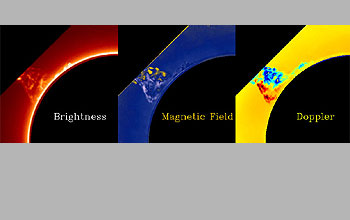News Release 04-073
Instrument Gets Breakthrough Image of Sun's Magnetic Halo

These images show the brightness, magnetic field strength, and Doppler velocity of an erupting ...
May 31, 2004
This material is available primarily for archival purposes. Telephone numbers or other contact information may be out of date; please see current contact information at media contacts.
ARLINGTON, Va.—A new instrument developed at the National Center for Atmospheric Research (NCAR) in Boulder, Colo., has captured landmark imagery of fast-evolving magnetic structures in the solar atmosphere. Steven Tomczyk of NCAR's High Altitude Observatory will present the images Monday, May 31, at the annual meeting of the American Astronomical Society (AAS) in Denver, Colo.
Animations from the coronal multichannel polarimeter, or COMP, reveal turbulent, high-velocity magnetic features spewing outward from the Sun's surface. The National Science Foundation (NSF), NCAR's primary sponsor, funded the instrument.
Says Paul Bellaire, program director for solar terrestrial research at NSF, "Space weather forecasters around the world provide tailored information to managers and policy-makers responsible for the infrastructure that supports our orbiting and Earth-based telecommunications, navigation and power grid systems. COMP's solar corona imaging capability will be a valuable tool for these forecasters, and for researchers of the near-Earth space environment, because the Sun is the driving force behind our space weather."
Data from COMP will help solar physicists relate magnetism in the corona to features emerging from the Sun, such as prominences and coronal mass ejections. Such features are the sources of "space weather"-the solar storms that can disable electric grids and satellites and interfere with radio communications.
COMP is expected to provide the best data to date on magnetic structures in the solar corona, the extremely hot halo around the Sun that becomes visible during eclipses. "People have measured coronal magnetism before," says Tomczyk, "but we believe this is the first time it's being done in a time sequence like this, where you can see an evolving structure. I think we're making important steps and demonstrating that this technology works."
The COMP data being presented at AAS were collected during tests in January and March at the National Solar Observatory in Sunspot, New Mexico.
COMP uses a telescope with a lens roughly eight inches wide to gather and analyze light from the corona, which is much dimmer than the Sun itself. It tracks magnetic activity around the Sun's entire edge, covering much more area than previous instruments. It also collects data far more often than its predecessors-as frequently as a measurement every 15 seconds.
Closer to the Sun's surface, magnetism has been traced for more than a decade by ground- and space-based instruments. These devices infer the magnetic field by measuring several components of visible radiation. Until recently, though, there was little hope of using this technique to analyze magnetism in the Sun's corona. Although the corona's temperatures are scorching (as high as 1.8 million degrees Fahrenheit, or 1.0 million degrees Celsius) the corona itself is far too thin to yield a strong signal. However, a new generation of super-sensitive, low-noise infrared sensors made COMP possible.
The NCAR team also devised a way to take images in two wavelengths of light at the same time. This allows scientists to filter out light scattered by Earth's atmosphere into the telescope's field of vision while preserving the faint signal from the corona.
COMP's developers hope to pair the instrument with a larger telescope. "Ultimately you want to gather more light," says Tomczyk. "This would give us more detail and allow us to gather data faster, so that both the temporal and spatial resolution could be improved."
-NSF-
Media Contacts
Cheryl Dybas, NSF, (703) 292-7734, email: cdybas@nsf.gov
Anatta , NCAR, (303) 497-8604, email: anatta@ucar.edu
The U.S. National Science Foundation propels the nation forward by advancing fundamental research in all fields of science and engineering. NSF supports research and people by providing facilities, instruments and funding to support their ingenuity and sustain the U.S. as a global leader in research and innovation. With a fiscal year 2023 budget of $9.5 billion, NSF funds reach all 50 states through grants to nearly 2,000 colleges, universities and institutions. Each year, NSF receives more than 40,000 competitive proposals and makes about 11,000 new awards. Those awards include support for cooperative research with industry, Arctic and Antarctic research and operations, and U.S. participation in international scientific efforts.
Connect with us online
NSF website: nsf.gov
NSF News: nsf.gov/news
For News Media: nsf.gov/news/newsroom
Statistics: nsf.gov/statistics/
Awards database: nsf.gov/awardsearch/
Follow us on social
Twitter: twitter.com/NSF
Facebook: facebook.com/US.NSF
Instagram: instagram.com/nsfgov


